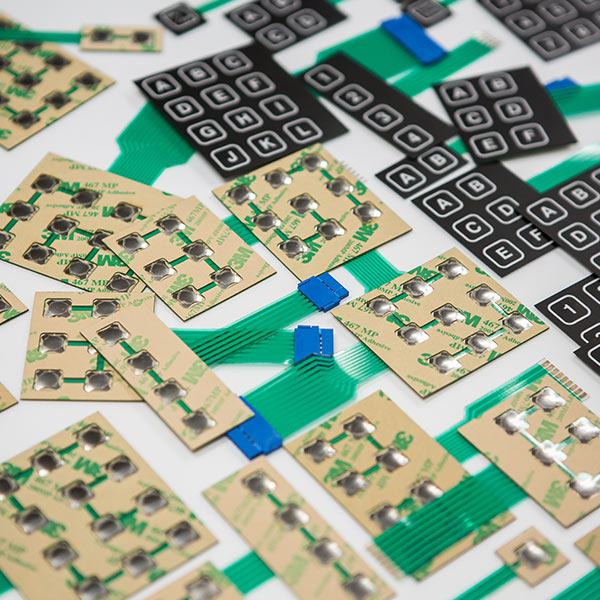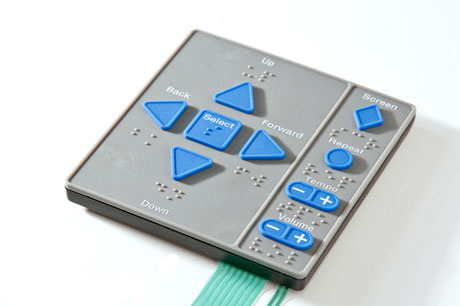Exactly How Membrane Switches Supply Smooth Operation in Harsh Atmospheres
Exactly How Membrane Switches Supply Smooth Operation in Harsh Atmospheres
Blog Article
Membrane Switches Explained: A Comprehensive Guide to Their Advantages
Membrane layer switches over represent a functional and innovative option for creating user interfaces across a selection of markets. As sectors increasingly look for reliable and efficient control user interfaces, understanding the particular advantages and applications of membrane layer switches becomes vital.
What Are Membrane Layer Buttons?

When stress is used to the membrane layer button, the layers make call, completing an electric circuit. This simple system permits a vast array of applications, from customer electronics to industrial machinery. Membrane layer switches are usually created to be waterproof and resistant to dirt and impurities, making them appropriate for environments where resilience is important.
Additionally, the flexibility of the materials used in membrane layer switches helps with cutting-edge styles that can adapt various shapes and measurements. This adaptability adds to their popularity in varied fields, including medical devices, automobile controls, and home appliances. On the whole, membrane switches stand for an important aspect in modern interface modern technology, linking the void in between individuals and digital systems.
Trick Advantages of Membrane Layer Switches
Among the myriad of individual interface choices available, membrane layer changes stand apart for their special mix of advantages. Among the main advantages is their portable and lightweight style, which enables assimilation right into a variety of devices without including considerable mass. This is especially advantageous in applications where space is restricted.
Furthermore, membrane layer changes deal resilience and resistance to ecological factors. They are generally created with products that can hold up against moisture, dust, and different chemicals, making them suitable for severe problems. This longevity adds to a longer lifespan contrasted to typical mechanical switches.
Another significant benefit is the versatility in customization. Membrane buttons can be published with different graphics, colors, and textures, permitting customized layouts that meet particular branding or practical needs. This adaptability extends to the variety of layers and circuit alternatives, providing engineers with numerous configurations.
In addition, the tactile feedback provided by some membrane layer switches over enhances customer experience, making them more instinctive to run. Lastly, the simplicity of cleansing and upkeep better solidifies membrane buttons as a useful choice in both customer and commercial applications. Membrane Switches. Generally, these vital advantages make them a recommended remedy for several designers and manufacturers
Applications in Numerous Industries
Just how do membrane buttons find their area throughout varied industries? Their convenience and performance make them essential parts in sectors varying from healthcare to customer electronic devices. In medical gadgets, membrane switches are made use of for their ease of cleansing and resistance to contamination, making sure hygiene in environments where sterility is essential.
In the customer electronics industry, these switches give smooth, user-friendly interfaces that improve item appearances while keeping toughness against deterioration. Automotive applications profit from membrane layer switches too, where they are used in dashboards and control board, supplying dependable efficiency in tough problems.
Furthermore, commercial equipment utilizes membrane layer buttons for control board as a result of their toughness, ability to stand up to rough environments, and adjustable layouts that deal with details operational demands. The food market leverages membrane switches for their convenience of use and resistance to spills, ensuring functional performance in hectic setups.
Ultimately, the adaptability of membrane layer switches throughout these diverse applications highlights right here their necessary duty in modern-day innovation, enhancing customer communication while satisfying industry-specific demands. Their proceeded evolution assures more assimilation right into emerging areas and ingenious items.
Design and Modification Alternatives
The layout and customization alternatives offered for membrane layer switches are critical for tailoring user interfaces to satisfy certain user needs and visual choices. These buttons can be developed in numerous forms, sizes, and formats, permitting smooth assimilation into diverse applications. The flexibility in design suggests that suppliers can produce unique user interfaces that enhance usability and preserve brand identification.
Customized appearances, colors, and graphics can be put on the surface area of the membrane switch, supplying a possibility for branding and user involvement. Additionally, backlighting alternatives, such as LED illumination, can be included to boost presence in low-light problems, thus boosting performance.
Practical components can additionally be customized, including responsive responses and actuation pressure, which can be adapted to suit different user interactions. The choice of products, such as polyester or polycarbonate, enables for variations in resilience and ecological resistance, satisfying the particular needs of various sectors.
Ultimately, the extensive layout and personalization capabilities of membrane switches make it possible for companies to create visually enticing and easy to use interfaces, ensuring that their items satisfy both functional and visual needs successfully. Membrane Switches.
Considerations for Implementation
Applying membrane layer switches over calls for cautious factor to consider of different aspects to make sure optimum functionality and customer experience. Factors such as direct exposure to wetness, severe temperatures, and chemical compounds can substantially affect the button's efficiency and long life.

One more essential aspect is the button's layout and format. Guaranteeing that the responsive responses and actuation force straighten with customer expectations enhances usability. Carrying out customer screening can give important understandings into the optimal style.
Additionally, compatibility with digital parts need to be assessed. The button's circuitry should straighten with the general system style, making certain dependable signal transmission and decreasing interference.
Moreover, production methods and costs need to be examined. The selection in between custom-made layouts and standard models can influence both spending plan and lead time.
Last but not least, consider repair and maintenance. Membrane buttons might call for specific cleansing and treatment treatments to keep their look and capability in time. By resolving these considerations, organizations can implement membrane switches that fulfill their functional needs while supplying a favorable customer experience.

Final Thought
In verdict, membrane switches over stand for a flexible and durable control user interface appropriate for a wide variety of applications my site throughout several markets. Their compact style, resistance to ecological aspects, and personalized features boost individual experience while conference specific branding needs. As innovation continues to advance, the importance of membrane buttons in modern-day devices continues to be like this considerable, supplying both functionality and aesthetic allure. Future advancements will likely better expand their applications and efficiency in different environments.
Membrane layer switches represent a advanced and functional option for producing customer interfaces throughout a selection of markets.Understanding the basic elements of contemporary digital interfaces, membrane switches are a type of individual interface gadget that are composed of flexible, thin layers of product. Overall, membrane switches over stand for an essential element in contemporary individual interface innovation, connecting the gap in between customers and digital systems.
Among the myriad of customer interface options available, membrane layer switches stand out for their one-of-a-kind mix of benefits.The design and personalization options readily available for membrane buttons are important for tailoring interfaces to meet details customer demands and visual preferences.
Report this page